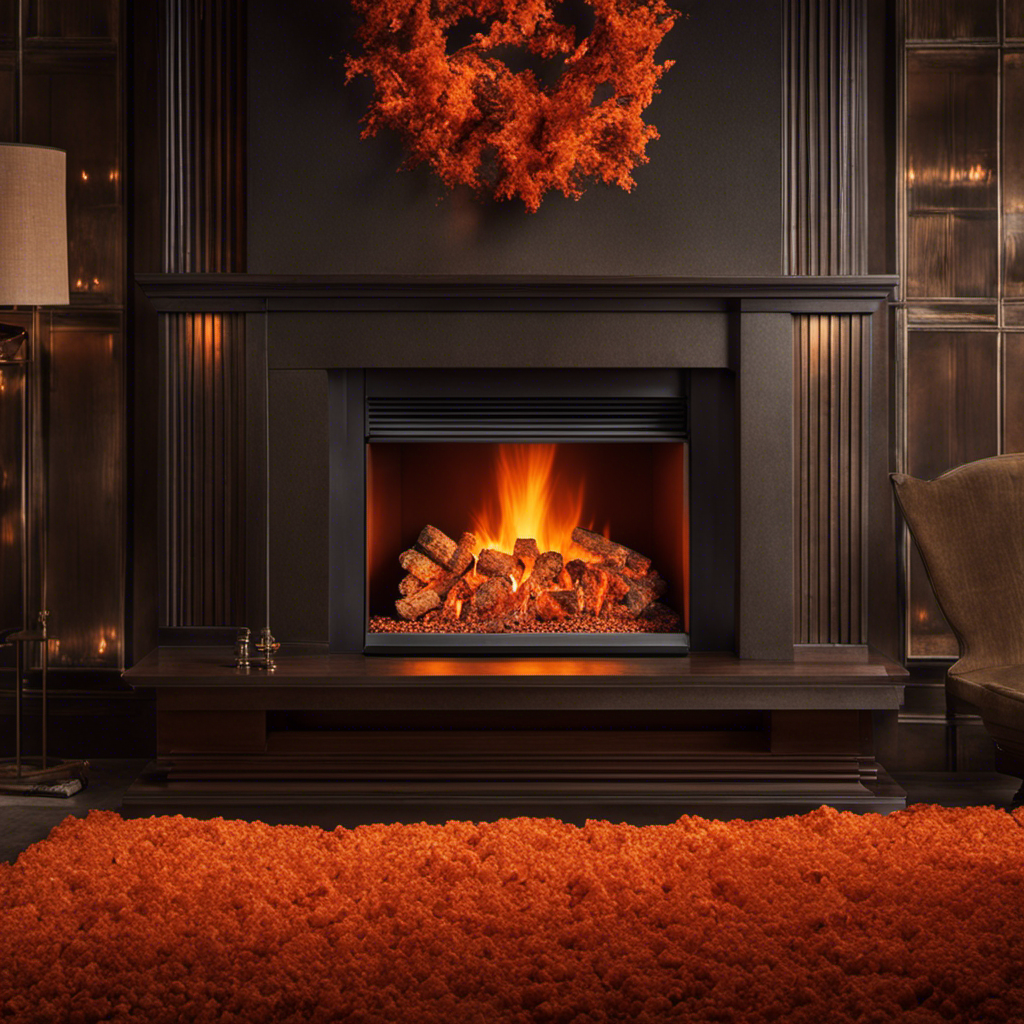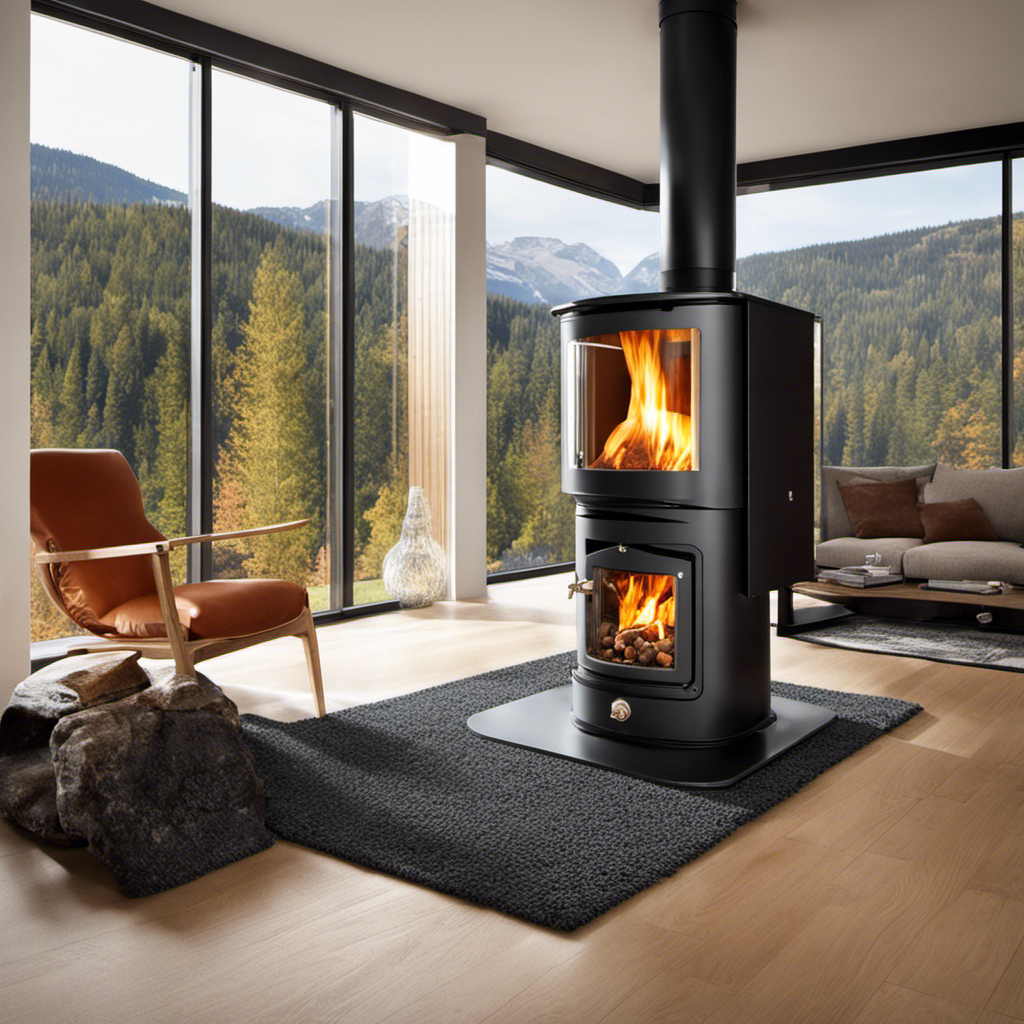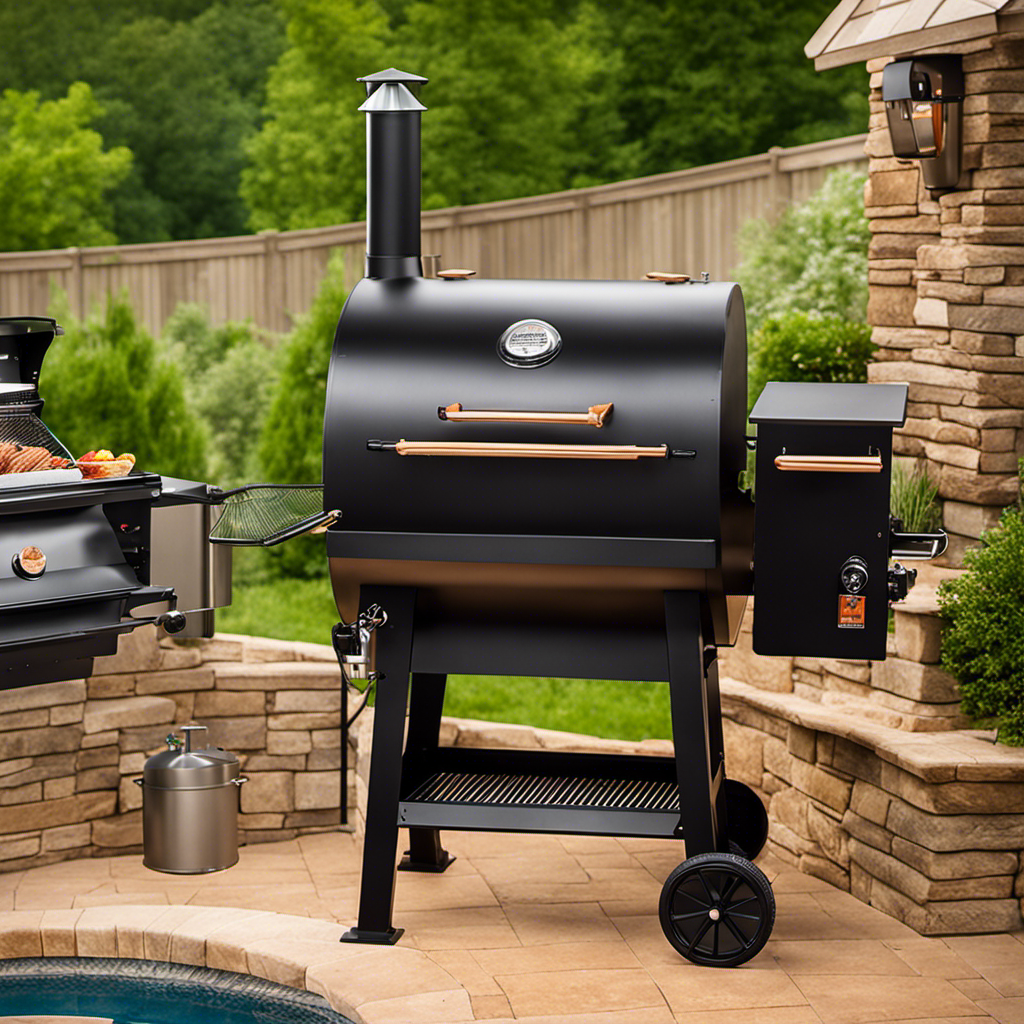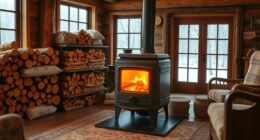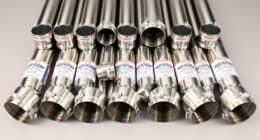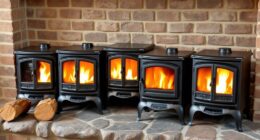As a homeowner, selecting the ideal stove insert is key to creating a cozy atmosphere in your home. However, with various options like gas, pellet, or wood, it can be difficult to find the perfect fit for your needs.
In this article, I will guide you through the key factors to consider, from energy efficiency to installation considerations, so you can make an informed decision.
Let’s explore the world of stove inserts together and find the perfect fit for your home.
Key Takeaways
- Gas stove inserts are highly efficient, produce fewer emissions, and result in lower energy consumption and utility bills.
- Pellet stove inserts can provide consistent and efficient heat, potentially lowering heating costs, but require a venting system and have higher installation costs.
- Wood stove inserts are the least expensive option in terms of installation and can lead to substantial savings on heating costs, especially with access to affordable or free firewood.
- Gas stove inserts have high heating performance, instant heat, and require less clearance, making them suitable for smaller spaces.
Energy Efficiency
If you’re looking for an energy-efficient option, a gas stove insert might be the best choice for you. Gas stove inserts are known for their energy savings and environmental benefits.
Compared to traditional wood-burning stoves, gas inserts are highly efficient in converting fuel into heat, resulting in reduced energy consumption and lower utility bills. They also produce fewer emissions, contributing to a cleaner and healthier environment.
Gas stove inserts are designed with advanced technology that maximizes heat output while minimizing heat loss, ensuring that every bit of energy is utilized effectively. This makes them a sustainable and eco-friendly option for heating your home.
Now let’s transition into the next section and discuss the cost comparison between gas, pellet, and wood stove inserts.
Cost Comparison
The cost of a gas, pellet, or wood stove insert can vary significantly. When considering which type of insert to choose, it’s important to weigh the initial installation cost against the long-term savings. Here are some factors to consider:
-
Gas Stove Insert:
-
Installation cost: Gas stove inserts tend to have a higher upfront cost due to the need for gas line installation.
-
Long-term savings: Gas inserts are generally more energy efficient than wood or pellet inserts, resulting in potential savings on heating bills over time.
-
Pellet Stove Insert:
-
Installation cost: Pellet stove inserts require a venting system, which can add to the installation cost.
-
Long-term savings: Pellet inserts offer consistent and efficient heat, potentially leading to lower heating costs in the long run.
-
Wood Stove Insert:
-
Installation cost: Wood stove inserts are typically the least expensive option in terms of installation.
-
Long-term savings: Wood inserts provide the opportunity for substantial savings on heating costs, especially if you have access to affordable or free firewood.
Considering the installation cost and long-term savings, it’s important to choose a stove insert that aligns with your budget and heating needs. In the next section, we will explore the heating capacity of different types of stove inserts.
Heating Capacity
When considering a heating system for your home, it’s important to compare the fuel efficiency of different options. This will help you determine which type of stove insert will provide the most cost-effective and environmentally friendly heating solution.
Additionally, understanding the variations in heat output and size requirements will ensure that you choose a stove insert that can effectively heat your space without taking up excessive room.
Fuel Efficiency Comparisons
Fuel efficiency varies between gas, pellet, and wood stove inserts. When considering fuel efficiency, it is important to understand the energy consumption and environmental sustainability of each option. Here are some key points to help you make an informed decision:
-
Gas stove inserts are highly efficient and have a steady heat output. They use natural gas or propane, which burns cleanly and produces minimal emissions. This makes them environmentally friendly and cost-effective in the long run.
-
Pellet stove inserts are also efficient and environmentally sustainable. They use wood pellets made from compressed sawdust or other biomass materials. These pellets are a renewable energy source and produce low emissions. However, they require electricity to operate, which should be taken into account.
-
Wood stove inserts have been used for centuries and provide a cozy ambiance. However, they are less efficient compared to gas and pellet inserts. They require regular maintenance and produce more emissions.
Understanding the fuel efficiency of different stove inserts is crucial for making an informed choice.
Now let’s explore the variations in heat output.
Heat Output Variations
To better understand the variations in heat output, you should consider the size and design of different stove inserts. The heat output of a stove insert is determined by the type of fuel it uses and its heating performance. Let’s take a look at the heat output variations among different fuel options:
| Fuel Option | Heating Performance |
|---|---|
| Gas | High |
| Pellet | Medium |
| Wood | Low |
As you can see, gas stove inserts generally have higher heating performance compared to pellet and wood stove inserts. This is because gas stoves provide instant heat and can be easily controlled. On the other hand, pellet stoves offer a medium level of heating performance, while wood stoves have a lower heat output. It’s important to choose a stove insert that matches your heating needs and the size of your space. Now, let’s discuss the size and space requirements for different stove inserts.
Size and Space Requirements
If you’re considering a stove insert, take into account the dimensions and space available in your home. It’s important to ensure that you have the appropriate installation space for the stove insert you choose. Different types of stove inserts have different clearance requirements, so make sure you are aware of these before making a decision.
Here are some key points to consider:
- Gas stove inserts usually require less clearance compared to wood or pellet stove inserts, making them a great option for smaller spaces.
- Wood stove inserts typically require more clearance due to the need for proper ventilation and safety regulations.
- Pellet stove inserts require a certain amount of space for the storage of pellets, so make sure you have enough room for both the insert and the pellets.
Considering these factors will help you choose the right stove insert for your home and ensure a safe and efficient installation.
When it comes to maintenance requirements…
Maintenance Requirements
When it comes to maintaining a stove insert, there are several key points to consider.
First, the cleaning frequency will depend on the type of fuel you use and how often you use the stove.
Secondly, proper ventilation is crucial to ensure the safety and efficiency of your stove insert.
Finally, your fuel type preference will not only impact the performance of the stove but also the maintenance requirements.
Cleaning Frequency
You should consider how often you want to clean your stove insert before making a decision between gas, pellet, or wood. Cleaning frequency can vary depending on the type of fuel used and the level of usage. Here are some cleaning techniques and safety precautions to keep in mind:
-
Gas Stove Insert:
-
Clean the glass regularly with a non-abrasive cleaner to maintain visibility.
-
Remove and clean the log set and burner assembly annually to ensure proper functioning.
-
Check for any gas leaks or blockages in the venting system regularly.
-
Pellet Stove Insert:
-
Clean the burn pot and ash pan weekly to prevent clogging and maintain efficiency.
-
Inspect and clean the venting system annually to remove any debris or blockages.
-
Follow manufacturer’s instructions for cleaning the auger and hopper to prevent jams.
-
Wood Stove Insert:
-
Clean the chimney and flue regularly to remove creosote buildup and reduce the risk of chimney fires.
-
Sweep out the ashes and debris from the firebox after each use.
-
Use a wire brush to clean the glass door when it becomes dirty.
By understanding the cleaning techniques and safety precautions associated with each type of stove insert, you can make an informed decision based on your cleaning preferences and needs.
Moving on to ventilation requirements, it is important to ensure proper airflow and ventilation within your home when using a stove insert.
Ventilation Requirements
Proper airflow and ventilation are essential for ensuring the safe and efficient operation of your stove insert.
When it comes to ventilation options, there are a few important considerations to keep in mind. First, you’ll want to ensure that your stove insert is properly vented to the outside of your home. This will help to prevent the buildup of harmful gases, such as carbon monoxide, which can be dangerous if not properly vented.
Additionally, it’s important to consider the placement of your stove insert in relation to other combustible materials. Be sure to follow the manufacturer’s guidelines for clearance distances to avoid any safety concerns.
Now that we’ve covered the importance of ventilation, let’s move on to discussing fuel type preferences.
Fuel Type Preferences
Now that we’ve covered the importance of ventilation, let’s dive into what type of fuel you prefer for your stove insert. When considering fuel type preferences, there are a few factors to keep in mind.
Here are three key considerations to help you make an informed decision:
-
Fuel Availability: Take into account the availability and accessibility of the fuel in your area. Gas stoves tend to have the most widely available fuel supply, while wood and pellet stoves may require more effort to source the fuel.
-
Carbon Footprint: Consider the environmental impact of each fuel type. Gas stoves produce the lowest carbon emissions, followed by pellet stoves, and wood stoves have the highest carbon footprint. Choosing a fuel with a lower carbon footprint can help reduce your environmental impact.
As we move into discussing the environmental impact of different fuel types, it’s important to consider their long-term sustainability and the effects they have on our planet.
Environmental Impact
The environmental impact of gas, pellet, and wood stove inserts should be considered when choosing the right option for your home. Each type of insert has its own carbon footprint and can affect the air quality in your living space.
Gas stove inserts are known for their low carbon emissions, making them a more environmentally friendly choice. They burn clean and produce minimal particulate matter, resulting in better air quality.
Pellet stove inserts also have a relatively low carbon footprint, as they use compressed wood pellets as fuel.
Wood stove inserts, on the other hand, have a higher carbon footprint due to the emissions released from burning wood. They can also contribute to poor air quality if not properly maintained. When considering the environmental impact, it is important to choose a stove insert that aligns with your sustainability goals and ensures good indoor air quality.
Considering the installation considerations, it is essential to evaluate the existing fireplace or the area where you plan to install the stove insert. The size and dimensions of the fireplace opening should be taken into account, as well as any necessary modifications that may be needed.
Additionally, the availability of fuel sources should be considered. Gas stove inserts require a natural gas or propane supply, while pellet stove inserts will need access to wood pellets. Wood stove inserts, on the other hand, will require a constant supply of firewood. It is important to ensure that these fuel sources are easily accessible and compatible with your chosen stove insert.
Installation Considerations
Consider evaluating the existing fireplace or the area where you plan to install the stove insert. This will help you identify any installation challenges and ensure that the insert will fit properly. Safety precautions are also crucial during the installation process. Here are three key points to keep in mind:
-
Ventilation: Ensure that your fireplace or the area where you plan to install the stove insert has proper ventilation to prevent the buildup of harmful gases.
-
Clearances: Check the manufacturer’s guidelines to determine the required clearances around the stove insert. This will help prevent any fire hazards and ensure proper airflow.
-
Chimney Inspection: If you plan to use an existing chimney, have it inspected by a professional to ensure it is in good condition and can handle the heat generated by the stove insert.
Considering these installation challenges and safety precautions will help you successfully install your stove insert.
Now, let’s dive into the exciting world of aesthetics and design options.
Aesthetics and Design Options
When it comes to aesthetics and design options, you’ll find a wide range of styles and finishes to choose from. Fireplace options are an important consideration when it comes to home decor and creating a cozy atmosphere.
Whether you prefer a traditional look or a more modern design, there are fireplace options to suit every style. From sleek and minimalist gas fireplaces to rustic and charming wood-burning stoves, the possibilities are endless. You can choose from various finishes such as stone, brick, or tile to complement your existing decor.
Additionally, you can customize your fireplace with mantels, surrounds, and accessories to make it truly unique. Remember, the right fireplace can become the focal point of your room and enhance the overall aesthetic of your home.
What are the differences between gas, pellet, and wood stove inserts, and how do I choose the right one for my needs?
Gas, pellet, and wood stove inserts differ in fuel type and heating capacity. Gas stoves are convenient and low-maintenance, while wood stoves provide a traditional ambiance. Pellet stoves offer automatic fuel feeding and are highly efficient. Consider your space, budget, and heating requirements to choose the right one for you. Ignitor installation wood pellet stove should be done by a professional for safety.
What Are the Differences Between Gas, Pellet, and Wood Stove Inserts, and How Do I Know Which One to Choose?
When considering installing a wood pellet stove ignitor, it’s important to understand the key differences between gas, pellet, and wood stove inserts. Gas stoves are convenient and simple to use, while pellet stoves offer eco-friendly heating. Wood stoves provide a traditional, rustic feel. Consider energy efficiency and maintenance requirements when choosing the right option for your home.
Frequently Asked Questions
Are There Any Safety Precautions I Should Take When Using a Stove Insert?
When it comes to using a stove insert, safety precautions are crucial. It’s important to follow manufacturer’s guidelines, keep the area clear of flammable materials, and have regular maintenance checks to ensure optimal performance and safety.
Can a Stove Insert Be Used as the Primary Source of Heating for My Entire Home?
Yes, a stove insert can be used as the primary source of heating for your entire home. However, it’s important to consider the fuel efficiency and pros and cons of each type (gas, pellet, or wood) before making a decision.
How Long Does It Typically Take to Install a Stove Insert?
Installation time for a stove insert varies depending on factors like the type of insert and any necessary modifications. It’s best to consult a professional for an accurate estimate. Additionally, different types of inserts have varying maintenance requirements.
Are There Any Specific Building Codes or Regulations I Should Be Aware of When Installing a Stove Insert?
When considering a stove insert, it’s important to be aware of building code requirements and installation regulations. These guidelines ensure safety and compliance, so it’s crucial to follow them during the installation process.
Can a Stove Insert Be Used During a Power Outage?
During a power outage, a stove insert can be a great alternative for heating and cooking. Gas, pellet, and wood stove inserts all provide heat without electricity, making them valuable during emergencies.
Conclusion
After carefully considering the factors discussed, it is clear that choosing between gas, pellet, or wood stove inserts ultimately depends on individual preferences and needs.
Whether it’s the energy efficiency of gas, the cost-effectiveness of pellets, or the traditional charm of wood, each option offers its own unique benefits.
By weighing the pros and cons of each type, one can make an informed decision.
Remember, the choice is like finding the perfect puzzle piece that completes your home’s warmth and style.




